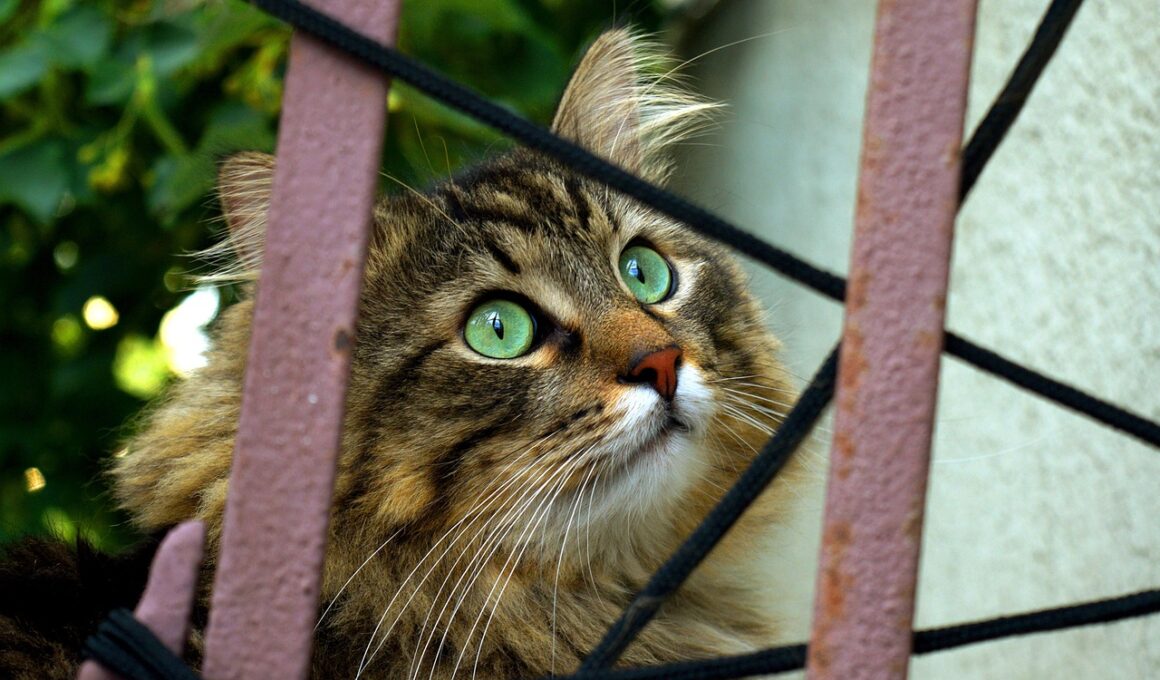The Role of Early Socialization in Adopted Cats’ Behavior
The process of adopting a cat is often filled with joy and excitement, but it is also a critical point for ensuring that the new feline companion adapts well. Early socialization plays an essential role in shaping the behavior of adopted cats. When done right, it aids the transition process from shelter to home. Cats that experience positive interactions during their early days in a new environment tend to exhibit more adaptable behaviors. Furthermore, early exposure to various experiences, including being handled and meeting different people, helps them develop trust. This trust is fundamental for cooperative behavior later on, creating a bond between them and their new guardians. Additionally, using rewarding techniques during socialization can enhance the bonding experience. Adopting a kitten or young cat provides the best opportunity for effective socialization, but older cats can adapt with patience. Recognizing individual needs during this period is vital. By fostering a safe environment, you enable your adopted cat to thrive and form fulfilling relationships. Remember, gradual introductions to other pets or family members can significantly affect their comfort levels and reduce stress.
There are several methods to enhance the socialization experience for adopted cats. First, creating a safe space within the house where they can retreat is important. This designated area allows the cat to explore its new surroundings at its own pace without feeling overwhelmed. Providing enrichment activities, such as toys or scratching posts, can also encourage exploration and play. Regular, positive interactions build trust and confidence in the cat. These interactions can include gentle petting, engaging in play sessions, or using treats to reinforce good behavior. Patience is crucial during this adjustment period, as some cats may take longer to acclimate. Introducing them gradually to family members and other pets helps with socialization too. It’s critical to monitor their reactions and respect their boundaries while progressing. For cats that show signs of anxiety or fear, consider consulting a veterinarian or animal behaviorist. They can suggest personalized strategies based on your cat’s specific needs. Establishing routines such as regular feeding times and play schedules can also provide a sense of stability. These approaches ultimately enhance the overall experience for both the cat and its new family.
Long-Term Effects of Socialization
Early socialization processes can have lasting effects on an adopted cat’s behavior. Cats that experience positive interactions in their early lives are less likely to develop behavioral issues such as aggression or anxiety later. Socialized cats are usually more confident and comfortable when meeting new people, which in turn reduces the stress associated with change. This adaptability makes them a pleasure to be around for many owners. Socialization can also impact a cat’s willingness to engage with their environment, leading to healthier physical activity habits. This promotes mental stimulation, which is essential for every cat’s well-being. Additionally, a well-socialized cat is often more receptive to training and learning new behaviors, making them easier to live with. Cats that are less fearful often explore more, helping to prevent boredom-related issues. As a result, adopting a cat that has undergone proper early socialization will likely lead to a harmonious household where both pet and owner enjoy their time together. Long-term success in behavior hinges greatly on the foundation laid during that critical socialization period. This is an investment that pays off significantly.
Responsibility in the socialization process extends beyond simply adopting the cat. Owners should commit to ongoing training and interaction. Using training techniques such as clicker training can yield positive reinforcement outcomes, allowing adopted cats to associate specific behaviors with rewards. Additionally, creating opportunities for the cat to engage socially with other cats can help further enrich their social skills. Outdoor safe spaces, such as enclosed patios, can allow adopted cats to explore the outside world safely. On the flip side, socializing doesn’t just benefit the cat. Owners often experience reduced stress from having an engaged and well-adjusted pet. Regularly spending time with a cat enhances the bond between them and their human companions. Recognizing cues and responding accordingly reinforces trust and encourages warm interactions. Furthermore, educating new owners about the importance of socialization can lead to more responsible pet ownership. This makes it essential for shelters and adoption agencies to provide valuable resources and workshops. Socialization should not be perceived as a one-time event; rather, it is an ongoing journey that flourishes with time and commitment from both ends.
Common Challenges in Socialization
While socialization is crucial for adopted cats, it is not without its challenges. Cats have individual personalities; some may be particularly shy or skittish, requiring more time to adjust. Recognizing signs of discomfort is essential for successful socialization. Signs may include hiding, excessive vocalization, or aggressive behavior in some cases. Ensuring a calm environment without loud noises or disturbances can help ease a cat’s anxiety. For particularly fearful cats, taking a step back may be necessary. This means allowing them to dictate the pace of introductions and interactions. In these instances, slow, patient approaches lead to better results. Providing hiding spots can also create a sense of security for fearful cats. It is imperative for owners to understand the importance of creating socialization opportunities that align with their individual cat’s comfort level. Consulting with professionals knowledgeable about feline behavior can provide valuable insights and techniques. These experts can guide owners through structured socialization plans tailored specifically to their cat’s temperament. Ultimately, overcoming these challenges can be incredibly rewarding for both the cat and its new family.
New families may also make common mistakes that interfere with socialization. Rushing the process is the most prevalent pitfall, as it can lead to increased anxiety and aversion. Owners often unintentionally force interactions, making cats retreat further into their shells. Instead, providing choice and letting the cat lead encourages successful connections. Furthermore, neglecting to provide stimulating activities can result in boredom and frustration. Engaging toys, vertical spaces, and scratching posts are essential tools for keeping a cat mentally engaged. This anticipation increases their willingness to approach and interact. Additionally, owners should be aware of their own emotions during the socialization process. A calm, positive demeanor can significantly influence the cat’s response to new experiences. Stressful situations for the owner will likely translate into stress for the cat. Therefore, practicing patience and setting reasonable expectations will foster a nurturing environment for their new companion. Taking the time to learn about feline body language can empower owners to respond appropriately during the process. Being proactive instead of reactive can develop a strong, lasting bond between cats and their human caregivers.
Final Thoughts on Cat Socialization
In conclusion, early socialization is a foundational aspect of integrating an adopted cat into a new home. New pet owners have the opportunity to shape their cats’ behavior positively through consistent and thoughtful interactions. By understanding that socialization is an ongoing process, they ensure that their cats become well-adapted companions. Each cat will react differently, and fostering this unique bond can lead to a loving relationship full of mutual respect. The commitment to engaging positively during the early days will yield lasting benefits. Well-socialized cats tend to show greater resilience against behavioral problems, making the extra effort worthwhile. Those contemplating adoption should consider their role in the socialization journey seriously. Successful socialization can turn a timid cat into a confident and loving pet. By attending to the best practices outlined in this article, new cat owners can provide an environment where their furry friends thrive. Ultimately, the joy derived from a well-adjusted pet far outweighs the challenges encountered along the way. With time, patience, and a loving approach, any adopted cat can flourish in its new home.
Investing time into socializing an adopted cat will reap rewards for both the feline and the owner. Each successful interaction leads to a happier household and a more fulfilling life for every party involved. The journey of socialization is an engaging and transformative experience that enhances the human-animal bond. It encourages understanding and empathy between pets and their guardians. By putting the principles of socialization into practice, owners can be proactive in creating a safe and secure atmosphere for their cats. Insights gleaned from this process not only help the cats but also enrich the owner’s life, fostering a deeper connection. It is fundamental for shelters to educate potential adopters about the significance of socialization prior to making a commitment. Education is key to nurturing well-adjusted pets, ensuring none are left behind as they embark on their journey to a forever home. The role of early socialization can’t be overstated; it serves as both the groundwork and the pathway to mutual trust and love. Every effort invested ultimately leads to a joyful coexistence between cats and their loving families.


